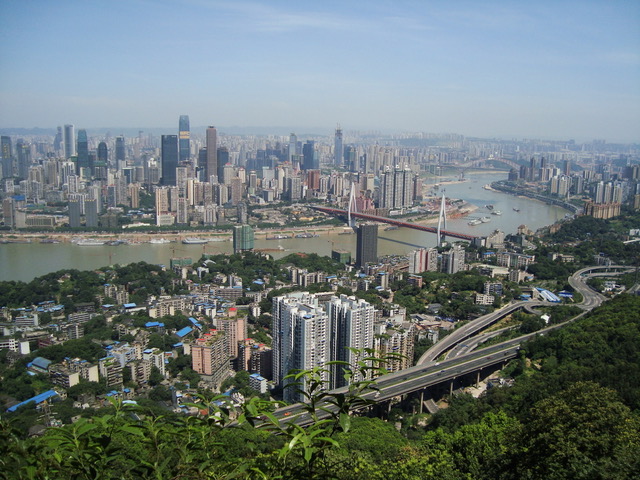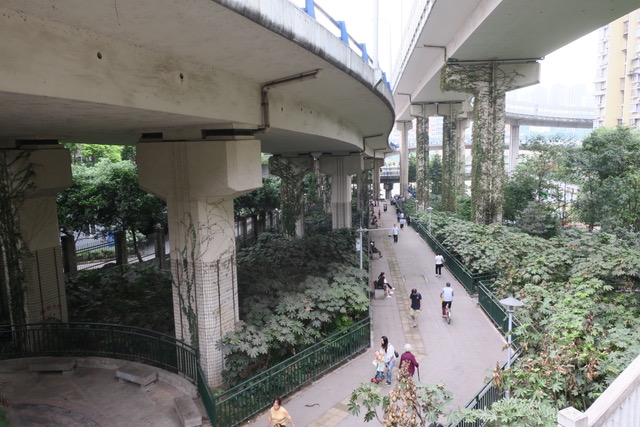
View on Chongqing inner city area from Laojun Dong Temple. (2015, Madlen Kobi)

Cooling in the shadow of highway bridges that crisscross Chongqing’s territory (2017, Madlen Kobi)
Together with Wuhan and Nanjing, the city of Chongqing has always been colloquially known as one of the ‘three furnaces’ in China. This contribution traces the history of heat mitigation in Chongqing since the 1950s which is closely intertwined with the architectural history of the city, e.g., building design, construction materials, green spaces, or the arrangement of houses. Based on five months of anthropological fieldwork, semi-structured interviews, and oral history, I analyze how residents cope with heat in and around the built environment. Until the 1990s, cooling down during the hot, humid and windless summers was mainly practiced outdoors: sleeping on the rooftops of multistory buildings, playing Mahjong in the streets, fanning oneself with a hand fan or installing bamboo beds in the compounds’ leafy courtyards. The availability of affordable electricity and the popularization of mechanical cooling reduced the reliance on natural conditions such as wind flows, shaded spaces or going to the riverside for cooling. I argue that these transformations have led not only to a relocation of cooling practices from the outdoors to the indoors, but also to an environmental degradation caused by energy production, and to a socio-economic stratification defining the ways in which residents mitigate heat.
The talk has been published here:
Madlen Kobi. 2023. “Urban Energy Landscape in Practice: Architecture, Infrastructure and the Material Culture of Cooling in Post-reform Chongqing, China.” Urban Studies.
@workshop HEATMATTERS
January 2023, Institute for European Ethnology, HU-Berlin
Transcript of audio summary
How it is to dwell in a furnace in a Chinese city during summer? This is a study I conducted between 2016 and 2020, more or less. I did fieldwork in 2017 and 2018, and later on I worked with an assistant who also compiled some oral histories. And you will see why these oral histories are interesting to understand body-infrastructure relations in Chongqing.
Temperatures in Chongqing have been rising more than the global trend. And this has, of course, caused urban heat island effects. In average, the temperature difference between urban and surrounding rural areas is around ten degrees Celsius. So, in the very urban area, a study measured 37 to 38 degrees, and in the rural areas around it was “only” 28 degrees Celsius. Actually, it’s very interesting because a widespread rumour says that there are many days when the temperature reaches more than 40 degrees Celsius, but the government often does not publish the real data because if it would be above 40 degrees Celsius these days count as “heat days”, and then the consequence would be people wouldn’t have to go to work and to school. So, in order to prevent that, the rumour says that actually official temperatures are always 38 or 39 degrees Celsius.
So, how do you keep cool in that hot and sticky climate? Until the mid-twentieth century, Chongqing’s building stock was dominated by what they call the wooden houses on stilts. So, these houses took advantage of the microclimatic conditions along the riverside. Here you can see Chongqing is located along the Yangtze River and also Jialing River. So, there are always hillsides on both sides of the river. And this creates kind of a cooling effect from downhill to the uphill. And ventilation was facilitated by these slopes. And in addition, houses were built in the way how you see it up there. So, they had what they call in the local language “breathable walls” made out of bamboo. And they also help to combat humidity and to facilitate ventilation. Later on, a lot of houses have been built by local rammed earth construction. This was very popular and also cheap to produce. And in the collective memory, people always talk about that these walls, they have the advantage of cooling in summer and keeping the heat in in winter. For indoor climate control, these socialist buildings, they had integrated many passive means. For example, cross ventilation was kind of integrated into the built structure. The buildings were rather narrow and they had windows on both sides, so ventilation was facilitated.
My informants, who lived in these buildings, they also recall that in the seventies and eighties, in summer, most apartments heated up tremendously. And so, the most pleasant place was actually outdoors in the shadowed spaces of the generally very green semi-public spaces. And so, they cooled down collectively in public or semi-public spaces.
So, the indoors have gained relevance to bear the summer and between 2002 and 2012, the number of air conditioning units per household has doubled from 1 to 2 units. So, there is really an increase of cooling the indoors also since the turn of the century. Not only private spaces, but of course also restaurants, and shopping malls.
Of course, the older construction knowledge, such as inclusion of ventilation and considerations of insulation, public greenings, they have been abandoned in this concrete and steel-dominated modernist architecture, which is now much more energy intensive. And in the case of Chongqing the cooling devices have not only changed the infrastructure and built fabric, but they have also affected the urban climate. So, my argument is that actually the rise in electricity consumption has led to environmental degradation, not in the city area anymore, but to other places.
A second price for cooling is also the changes in social life. With this transition from a socialist to a post-reform period, Chongqing residents’ heat mitigation strategies, they shifted from more collective communal ways of cooling to individual retreats in cooled indoor spaces.
A third price for cooling is socioeconomic stratification. In the socialist period, Chongqing residents’ way of cooling was not shaped by their incomes because the shaded outdoor spaces could be enjoyed by everyone. In the eighties, residents then purchased electric fans, window air conditioning, and later split unit air conditioning. So, the purchase of these devices has, of course, depended on the socioeconomic means of a family because the costs for running these devices have not been affordable for everyone.
The past dependency of concrete and steel modernism and the construction of poorly insulated high-rise buildings neglects the previous thermal knowledge that was integrated into a building’s design. And today’s high-rise buildings, they are widely responsible for the high electricity dependency in heat mitigation.
And we think that the urban thermal governance of the future would do well to combine these insights from urban climatology, ethnography, and architectural design. Modern architecture has failed to recognise the energy potential that could be found in the immediate surroundings, and we think it’s necessary to also revise and think through the local practices of the past in order to develop an architecture of the future. We certainly have to continue mapping and simulating climatic conditions. But we also think it’s very important to take into account qualitative data, especially ethnographic data, because factors such as energy pricing, governmental infrastructure investments or social expectations are as important or impact urban climates as much as wind speed and humidity do. And that’s why we think there needs to be an interdisciplinary collaboration in the future. So urban planners and designers, they must consider the thermal realities of the place of intervention to understand economic, political, social and cultural aspects that intervene in climate control.